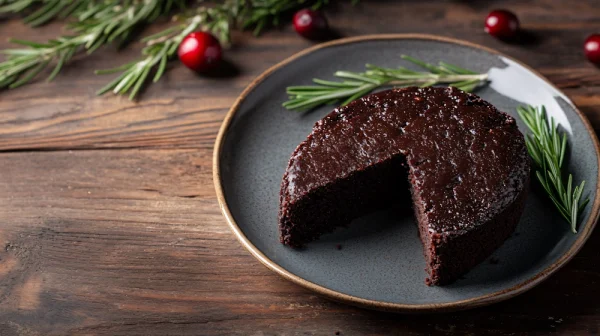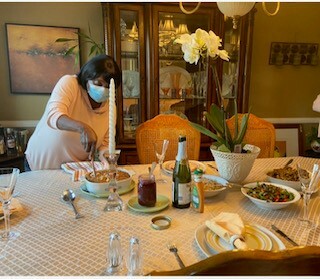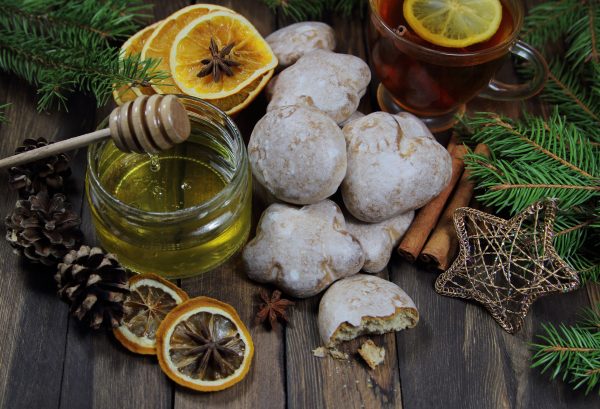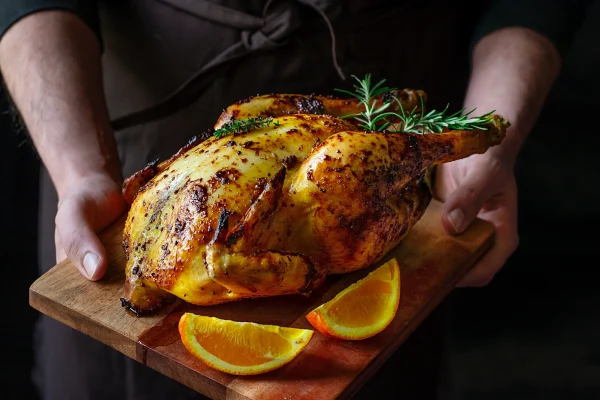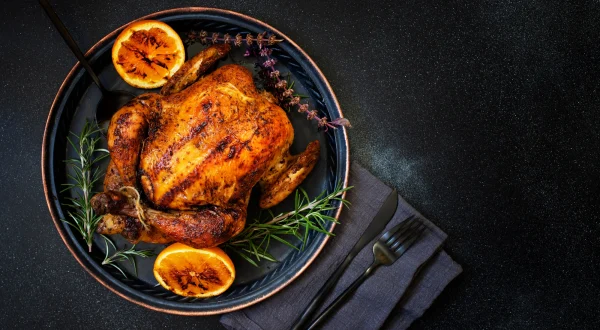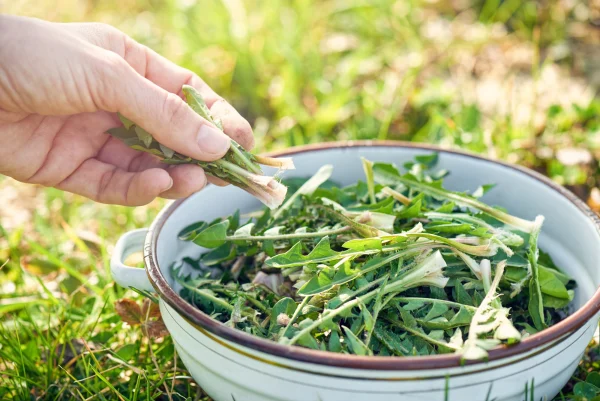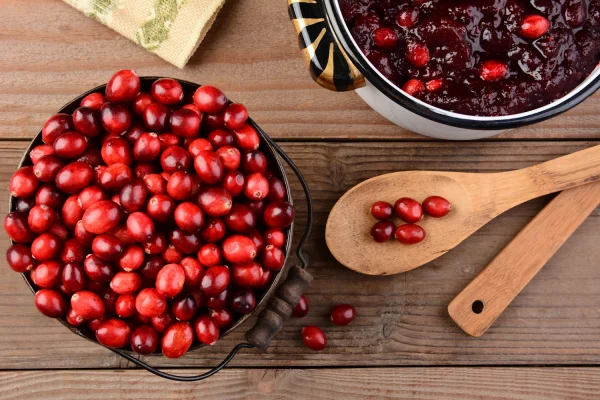
About Chefs’ Choir®
A chorus of culinary voices from Great Performances—our chefs step out of the kitchen to share recipes, stories, and inspiration. Learn more →
Event Producer Jenell Cruickshank shares a recipe from her Auntie Nadia – a delicious cranberry chutney that’s the perfect accompaniment to a holiday meal – and that makes a special gift for everyone to take home.
In my family for the holidays, we all have our responsibilities to make a beautiful spread. The things you look forward to when you visit family, especially traditional Jamaican items, Rice and Peas, Sorrel, Oxtails, Rum Cake etc. (I only do the veggies and bring the flowers lol). Auntie Nadias Cranberry Chutney has become a sweet/savory treat we look forward to, plus everyone gets a jar to take home! The gift that keeps on giving 😊
Auntie Nadia's Words
I was shopping for ingredients to make a fruit platter for Raynor’s (her son) elementary school Christmas party. While doing that I came across fresh cranberries and thought they’re beautiful red color would be great on a fruit platter for Christmas, but when I got home and tried them, I said no too tart, children would not care to eat those. I thought I would eat them but after a couple days they were too tart even for me. So, I went looking for other ways to use up these cranberries. That’s when I found a recipe in an issue of Oprah Magazine. I’ve tweaked it and made my own variation of the original recipe for many years now. My family and friends continue to enjoy.
Auntie Nadia's Cranberry Chutney
by Auntie Nadia
Makes 8 cups or about 4 pint size jars.
Ingredients
- 4 cups fresh or frozen cranberry picked over and stemmed
- 2 ½ cups sugar
- 6 Whole Cloves
- 2 – 3” cinnamon sticks
- 1 tsp salt
- 2 (6oz) Granny Smith Apples Peeled, Cored & Cut into ½ inch dice
- 1 ( 5oz) yellow onion diced
- 1 cup golden raisins
- 2 firm (6oz) Bosc or Anjou Pears, Peeled, Cored & cut in ½ inch dice
- 1/3 cup diced crystallized ginger
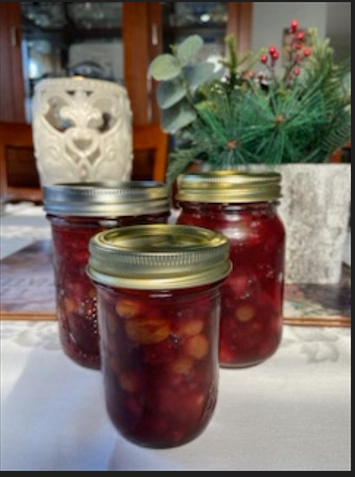
Procedure
In a deep 6 qt. saucepan combine cranberries, sugar, 11/2 cup water, cloves, cinnamon sticks and salt.
Bring to boil over medium heat, stirring frequently to dissolve sugar.
Cook until berries begin to pop, 10-12 minutes. Adjust heat so mixture barely simmers.
Stir in apples, pears, onion, raisins, and ginger. Continue to cook stirring frequently until thick, 10-12 minutes longer.
Remove from heat and allow mixture to cool to room temperature.
Discard visible cinnamon sticks and cloves.
Refrigerate in tightly sealed jars for up to two months.
Attach a ribbon and gift tag with suggested serving ideas e.g. serve with Christmas turkey or ham or spread on turkey sandwiches.
More Recipes from Jenell's Aunties
Holiday Party | 8 1/2 @ 9 W 57th | Senior Event Director Jodi Smith
Midtown’s Sophisticated New Venue for Modern Gatherings
Nestled in the heart of Midtown Manhattan at 9 West 57th Street, 8 1/2 has officially opened its doors for catering and events, offering a stunning new setting for corporate celebrations, seasonal parties, and sophisticated social gatherings.
A contemporary reimagining of a classic New York space, 8 1/2 balances modern luxury with dramatic architectural elements. The venue’s sweeping circular staircase, polished finishes, and striking multi-level layout create a natural sense of arrival. Soft curves, warm textures, and soaring sightlines make it an unforgettable backdrop for events that call for something elevated yet inviting.
Whether hosting an intimate reception or a full-scale holiday celebration, guests are immediately immersed in an atmosphere that feels at once grand, modern, and unmistakably New York.
Event Gallery
A Holiday Celebration to Welcome the Space
To mark the opening of the venue, we recently hosted an internal holiday gathering—an evening designed to experience the space exactly as our guests would. With approximately 75 attendees utilizing half the venue, the event showcased how beautifully 8 1/2 accommodates open-flow reception formats, interactive stations, and dynamic guest movement across levels.
Seasonal décor accented the venue’s architecture—the curve of the staircase wrapped in greenery, warm red and green light washing the walls, and a glowing tree anchoring the lounge area. Elegant high tops, lounge seating, and clear modern chairs allowed the room’s design to shine while still offering comfort and flexibility.
Throughout the evening, guests explored curated food stations, enjoyed butlered hors d’oeuvres, sipped winter cocktails, and lingered in conversation across both levels of the venue. Even at half capacity, the space felt full of energy without ever feeling tight—an ideal balance for receptions, client events, and team celebrations.
The Menu: Seasonal, Abundant & Designed for Mingling
Our culinary team crafted a menu that celebrated winter flavors and the interactive nature of the space. Guests enjoyed a wide range of options—from passed bites to sushi to hot stations—allowing them to graze, taste, and connect throughout the evening.
Event Menu
Patatas Bravas with Garlic Aioli & Salsa Brava (Vegan, GF)
Crispy Arancini with Tomato Marinara (Vegetarian)
Truffled Mac & Cheese Bites (Vegetarian)
Coconut Shrimp with Apricot Mustard
Maryland Crab Cakes with Chesapeake Remoulade
House-Made Kosher Pigs in a Blanket with Deli Mustard
BBQ Short Rib on Stone-Ground Grits with Roasted Poblano (GF)
Chicken Satay with Lime, Cilantro & Fresh Chiles (GF)
Hot & Spicy Chicken Meatball with Thunder Pickle Remoulade
NY Carvery
Cedar-Planked Salmon with Honey & Charred Lemon (GF, DF)
Twice-Baked Mini Potatoes with Cheddar & Herbs (Vegetarian, GF)
Gruyère Creamed Spinach (Vegetarian, GF)
Classic Caesar Salad with Parmesan & Sourdough Croutons
Rustic Breads: Sourdough Boule, Ciabatta, Pugliese & Baguette
Chef Carving Station
Herb-Seared Strip Steak
Sauces: Chimichurri, Horseradish Cream & Mustard Sauce
Pasta Stations
Truffled Fall Orecchiette (Vegan)
Garganelli with Short Rib Bolognese
Sushi Station
Prepared onsite by sushi chefs
Rainbow Maki
Ichiban Roll
Crouching Tiger Roll
Salmon Avocado Maki
Spicy Tuna
California Roll
Avocado Cucumber
“You’re Just a Sweetie” Roll (vegetable & forbidden rice)
Soy Sauce, Pickled Ginger & Wasabi
Flourless Chocolate Cake Bites (GF)
Vanilla Cream Bombolini
Pumpkin Cheesecake Bites (GF)
S’mores Squares
Spiced Pear Margarita
Tequila, pear purée, lime, cinnamon honey syrup, cinnamon stick garnish, cinnamon-sugar rim
Why 8 1/2 Is Perfect for Holiday Parties — December & January
With its central location, dramatic design, and flexible multi-level layout, 8 1/2 is an exceptional choice for:
- Corporate holiday parties
- Client receptions
- Team celebrations
- Milestone gatherings
- January holiday parties
The space shines during the holiday season, but its sculptural architecture and warm palette make it equally compelling year-round for events that deserve something truly memorable.
Plan Your Holiday Party or Seasonal Gathering
Whether you’re looking to host a last-minute holiday celebration this month or planning a January event to kick off the new year, our team is ready to help you create an unforgettable experience at 8 1/2 Events & Catering.
At Great Performances, we believe that nourishment is a cornerstone of community—and this year, we were proud to help strengthen that foundation through our partnership with DREAM Charter Schools. As DREAM launched its innovative Community Resource Hub at the 20 Bruckner Campus, we supported the effort by donating the fresh, farm-grown produce that families often struggle to access.
Through Katchkie Farm, our organic farm in Kinderhook, we contributed nearly 2,700 pounds of vegetables to help stock the school-based pantry with ingredients that bring both nutrition and dignity to every household. From tomatoes, carrots, and potatoes to kale, squash, herbs, and more, each week’s harvest expanded what DREAM could offer to families and deepened the impact of the pantry pilot.
This collaboration reflects our shared belief that nourishing a community begins with meeting essential needs—and that when organizations unite around care, equity, and access, families thrive. We’re honored to partner with DREAM as they build a model that supports students and families not only in the classroom, but at home and around the table.
Partnership in Action: Nourishing Families, Strengthening Community
At DREAM Charter Schools, we believe that every child deserves the foundation to thrive, academically, socially, and physically. But for many families we serve, the path to success begins not just in the classroom, but at the table. With 89% of our students qualifying for free and reduced-price lunch and 85% of our families receiving HRA benefits, food security remains one of the most pressing challenges in our communities.
This year, we took a bold step forward by launching the DREAM Community Resource Hub at our 20 Bruckner Campus, a school-based pantry pilot designed to ensure that our families have consistent, dignified access to nutritious food right where they already feel safe: at school. Each week, the Hub distributes balanced pantry bags filled with grains, proteins, dairy, vegetables, and, thanks to a remarkable partnership, fresh produce.
One of those partnerships is with Great Performances, whose weekly produce donations have transformed what our pantry can offer. Their commitment allows us to include fresh vegetables, items that are often among the most expensive and hardest for families to access. It’s not just about the food; it’s about the message it sends: that our families deserve quality, nourishment, and care.
In just a few months of the pilot, we’ve served 881 families and distributed the equivalent of hundreds of meals. Each pantry bag, designed to provide about 15 meals, helps ease the strain on households and strengthens our shared goal of growing the whole child by addressing the basic needs that underpin learning, wellbeing, and community stability
For DREAM, “DREAM is Family” isn’t just a motto, it’s a way of operating. By bringing together partners like Great Performances, we are building a model that not only feeds families but connects them to critical resources such as SNAP, WIC, and Health Bucks.
Our long-term vision is ambitious but clear: to expand the Community Resource Hub model across all DREAM campuses, ensuring that every DREAM family, no matter their current circumstances, has a reliable way to secure food and support services that enable them to play, learn, and grow.
Partnerships like the one with Great Performances make that vision possible. Their generosity reflects what happens when mission-driven organizations unite around shared values, when we see food not just as sustenance, but as a tool for dignity, connection, and hope.
Together, we’re proving that nourishing our families is the first step to nourishing our future.
About Raymie Fernandez
Raymie Fernandez serves as the Chief Operating Officer at DREAM, bringing 14 years of experience in education and 18 years in youth-serving organizations to his leadership. A native of Harlem, Raymie has been connected to the DREAM community since childhood, when he grew up in the neighborhood and played baseball against DREAM formerly known as Harlem RBI. He formally joined DREAM in 2021.
As COO, he oversees network and school-based operations across DREAM, including facilities, food services, health and safety, transportation, and procurement. He leads and develops a broad team of direct reports and dotted-line leaders whose portfolios span school operations, network operations, student enrollment, facilities, and food services.
Raymie also oversees DREAM Charter Schools’ work in health and wellness, including the scratch food program and the launch of DREAM’s first-ever community pantry, the Community Resource Hub, advancing DREAM’s commitment to holistic support for students and families.
This season, we were proud to support a series of extraordinary events that brought together leaders in science, the arts, and horticulture. Each celebration showcased the power of creativity, collaboration, and community — and we’re excited to share a closer look at these inspiring gatherings.
World Science Festival Gala 2025
A Celebration of Innovation and Imagination
The World Science Festival Gala transformed Jazz at Lincoln Center into a dynamic fusion of art, science, and culinary creativity — complete with futuristic touches like a robotic bartender and a sensory-driven dinner experience. The evening honored ten groundbreaking thinkers whose work has helped shape our understanding of the world.
Find Your Light Foundation: Second Anniversary Celebration
An Evening Illuminating the Power of Arts Education
Warm, joyful, and filled with nostalgia, this year’s Find Your Light celebration highlighted the foundation’s mission to expand arts education nationwide. Guests enjoyed uplifting performances — and a delightful surprise appearance by rubber duckies inspired by Sesame Street — all underscoring the foundation’s commitment to creativity and opportunity.
Wave Hill Gardeners’ Party 2025
Honoring the Art and Legacy of Gardening
Set against the lush landscape of Wave Hill, this special evening celebrated the institution’s 60th anniversary and paid tribute to its founding Director of Horticulture, Marco Polo Stufano. Guests enjoyed a late-summer menu inspired by Mediterranean flavors while sharing in a heartfelt appreciation for nature, artistry, and community.
At Great Performances, our story began in the arts. Founded as a waitress service for women in the performing arts, we’ve grown into one of the country’s leading catering and hospitality companies — yet our connection to culture, creativity, and community has never wavered. We’re proud to partner with theaters, museums, performance venues, and arts organizations across New York and beyond, fueling the experiences that inspire audiences every day.
As someone who travels around the world to experience theater — from major premieres to hidden-gem regional productions — I’m always excited for the upcoming season. And looking ahead to 2026, an extraordinary lineup of theater, opera, and new works is ready to take center stage. Whether you’re crafting your cultural calendar or searching for the perfect stocking stuffer (nothing beats the gift of live performance!), here are the productions topping our watchlist.
Broadway & New York Premieres
Two Strangers (Carry a Cake Across New York)
- Longacre Theatre
- Opens November 20, 2025
A vibrant, contemporary musical following an unlikely duo — an upbeat Brit and a no-nonsense New Yorker — navigating secrets, second chances, and the magic of the city.
Stocking Stuffer Alert: A charming pick for anyone who loves modern, heart-forward musicals.
GIANT
- Music Box Theatre
- Previews March 11, 2026
- Opens March 23, 2026
A gripping portrait of Roald Dahl and the scandal that shook his legacy. After a lauded West End run, this thoughtful, provocative drama arrives on Broadway with high expectations.
CATS: The Jellicle Ball
- Broadhurst Theatre
- Previews March 18, 2026
Fresh off its PAC sold out run, a reimagined, ballroom-infused revival of Andrew Lloyd Webber’s classic. With bold choreography, glittering design, and a Vogue-worthy edge, this production promises to be one of the season’s most talked-about events.
Joe Turner’s Come and Gone
- Barrymore Theatre
- Previews March 30, 2026
- Opens April 25, 2026
August Wilson’s powerful 1911-set masterpiece returns, exploring identity, healing, and the resilience of Black travelers navigating the Great Migration. A must-see for lovers of rich, character-driven drama.
Moby Dick
- BAM – Howard Gilman Opera House
- April 29 – May 3, 2026
Robert Wilson’s visually striking, avant-garde retelling of Melville’s novel lands at BAM, featuring a haunting score by indie musician Anna Calvi. Expect something bold, hypnotic, and wholly original.
El Último Sueño de Frida y Diego
- The Metropolitan Opera
- May 14 – June 5, 2026
A magical-realist opera that brings the tempestuous love story of Frida Kahlo and Diego Rivera to vivid life. With a luminous score by Gabriela Lena Frank and staging inspired by the couple’s iconic artwork, this is a standout for opera and visual arts lovers alike.
Beyond Broadway: Regional Highlights
Come From Away
- Paper Mill Playhouse
- February 4 – March 1, 2026
The beloved musical returns locally, celebrating community, kindness, and the power of human connection.
The Recipe
- La Jolla Playhouse
- February – March 2026
A funny, heartfelt new play tracing Julia Child’s early years — from Pasadena to Paris and beyond — as she discovers her passion, purpose, and voice. A perfect match for the food-and-culture lovers in our GP community.
Support the Arts — Wherever You Are
As you plan your 2026 arts adventures, remember that the magic of live performance thrives not only on Broadway and major stages, but in communities everywhere. Consider supporting:
- National tours bringing Broadway favorites across the country
- Regional theaters developing new work
- Community playhouses that nurture local talent
- High school and college productions where the next generation of artists takes the stage
Every ticket purchased helps keep the arts vibrant, accessible, and sustainable.
At Great Performances, we’re honored to continue uplifting the artistic spirit that started our journey — and we can’t wait to see where 2026 takes us, on stage and beyond.
World Science Festival Gala 2025 | Jazz at Lincoln Center
On October 27th, we supported the World Science Festival Gala, an event that blended scientific inspiration with thoughtful design and a modern, tech-driven guest experience.
The highlight of the evening was the Barsy 360, which drew steady attention throughout the night. Barsy served the event’s featured drink, the Margarita al Carbon with activated charcoal, offering guests a fun and unexpected touch that aligned well with the science theme.
The gala also recognized ten influential figures whose contributions shaped science, medicine, environmental advocacy, and human rights, including: Hypatia of Alexandria, Lucilio Vanini, Galileo Galilei, Nikolai Vavilov, Linus Pauling, Andrei Sakharov, Wangari Maathai, Ignaz Semmelweis, Rachel Carson, and Frances Oldham Kelsey.
Event Gallery
Event Menu
This year our team delivered a menu rooted in creativity and quiet scientific playfulness. Each course carried a subtle element of exploration—textures, temperatures, unexpected contrasts—all served on custom trays chosen specifically for each bite.
- Green Chickpea Pani Puri – Mint, Candied Cumin Seeds
- Truffle Crème & Duxelle Puff – Truffled Creme, Pickled Pioppini, Chervil
- Butternut & Fig Tartlet – Goat Cheese, Toasted Pistachio
- Mushroom Tea – White Piopini, Enoki, Chanterelle, Morel, Smoked Mushroom Tea, Helio Cress,
- Fish & Chip Taco – Potato Taco Shell, Mushy Peas, Malt Vinegar Remoulade, Chives
- Fluke Ceviche – Leche De Tigre, Cilantro, Chili Pepper Pearl, Neon Rice Crisp
- Chinese Pancakes with Duck – Duck Confit, Ginger Rhubarb Jam, Pea Greens
- Seeds of Wisdom & Pearls of Knowledge – Soju Poached Apple, Sesame Tofu Bonbons, Shiso, Soy Pearls, Black Sesame Powder
- French Onion Short Rib – Caramelized Onion, Gouda Gratin, Broccolini, Crispy Thyme
- Soy Orange Braised Daikon (vegan) – Bok Choy, White Sesame Seeds, Forbidden Rice, Flower Yuzu Pearls, Fresh Herbs
- The Pearfect Experiment – Hazelnut Biscuit, Maple Red Wine Poached Pears, Candied Hazelnuts
- Carrot Cake & Pineapple (vegan, GF)- Vegan Cream Cheese Frosting, Pineapple Fluid Gel, Pickled Golden Raisins, Affilla Cress
The 2025 World Science Festival Gala honored those who pushed the boundaries of human knowledge, and the event itself echoed that mission. With its inventive menu and an unforgettable robotic bartender, the evening reminded us that science isn’t only something we learn—it’s something we feel, witness, and celebrate together.
Find Your Light Foundation Gala | Jazz at Lincoln Center
This past October, we were honored to support the Find Your Light Foundation Gala, hosted by Josh Groban. Find Your Light’s work has long championed creativity as a pathway to confidence, opportunity, and joy — a belief deeply shared by Great Performances and our partners at Jazz at Lincoln Center.
One of the highlights of the evening was the Foundation’s tribute to Sesame Street, a cultural touchstone that has shaped generations through music, curiosity, and compassion. Their performance brought an unmistakable energy to the room — made even more charming by the surprise rubber duckies gifted to every guest, a playful nod that quickly became the unofficial icon of the night.
Beyond the celebration, the gala underscored something essential: when organizations rooted in the arts come together — Find Your Light through arts-education grants, Jazz at Lincoln Center through youth development and fellowships, and Great Performances through our long-standing commitment to nurturing emerging talent and creative communities — the impact multiplies. This shared mission continues to guide our growing collaboration.
Event Gallery
Event Menu
- Mighty Mushroom Maki Roll
- Carrot Tartare Cup
- Butternut & Fig Tartlet
- Lobster Roll
- Rare Seared Tuna with Apple–Celery Root Remoulade
- Grilled Chicken Taco with Chili Crema
- Boneless Lamb Chop with Mint Chimichurri
- Spaghetti & Meatball Bite
New York Steakhouse Station
Strip Steak
Smoked Cedar-Planked Salmon
Truffled Orecchiette
Wild Mushrooms
Twice-Baked Creamed-Spinach Potatoes
Waldorf Salad
Parker House Rolls
Classic Steak Sauces
Dim Sum Station
Vegetable and Chicken Dumplings
Short Rib and Eggplant Bao Buns
Vegetable Fried Rice
Crispy Noodles
Seaweed–Cucumber Salad with Traditional Accompaniments
Desserts
Cheesecake Lollipops
Fruit Tartlets
Key Lime Tartlets
Chocolate–Raspberry Truffles
S’Mores Squares
Carrot–Ginger Cake
About Chefs’ Choir®
A chorus of culinary voices from Great Performances—our chefs step out of the kitchen to share recipes, stories, and inspiration. Learn more →
Chef Omar Hegazi recently joined the Great Performances team as Corporate Chef de Cuisine and shares his recipe for a luscious Braised Lamb Shank.
Although this is not a traditional American holiday dish, it is a traditional recipe from where I am from.
Braised Lamb Shank
by Chef Omar Hegazi
Ingredients
- 4–6 lamb shanks
- 2 tsp salt
- 1 tsp black pepper
- 2–3 tbsp olive oil
- 1 large onion, chopped
- 3 carrots, chopped
- 2 celery stalks, chopped
- 6 cloves garlic, smashed
- 2 tbsp tomato paste
- 1.5 cups red wine
- 2 cups beef or chicken stock
- 1 can (400 g / 14 oz) diced tomatoes
- 2–3 sprigs fresh rosemary
- 4–5 sprigs thyme
- 2 bay leaves
Procedure
Prep the Lamb: Pat lamb shanks dry. Season generously with salt and pepper.
Sear: Heat olive oil in a heavy Dutch oven or deep oven-safe pot over medium-high heat. Brown shanks on all sides (8–10 minutes). Remove and set aside.
Sauté Aromatics: In the same pot: add onion, carrots, celery and cook 5–7 minutes until softened. Add garlic and tomato paste; cook 1 minute to caramelize
Deglaze: Pour in the red wine. Scrape up the browned bits. Simmer 3–4 minutes to reduce slightly.
Add Liquids & Herbs: Add stock, diced tomatoes, rosemary, thyme, and bay leaves. Return shanks to the pot, submerging them partially.
Slow Cook Braise:
• Cover and place in preheated oven set at 325°F for 2.5–3 hours, turning shanks halfway.
• They’re done when the meat is very tender and nearly falling off the bone.Reduce the Sauce: Remove shanks and simmer the sauce uncovered for 10–15 minutes until thicker.
More Recipes by Chef Omar Hegazi
About Chefs’ Choir®
A chorus of culinary voices from Great Performances—our chefs step out of the kitchen to share recipes, stories, and inspiration. Learn more →
A sweet add-on to their article, Holiday Cooking with the Deuel Family, Anastassia adds a special recipe for her Holiday Honey Pryanik Cookies.
Inspired by Anastassia’s Russian roots, these soft honey cookies bring warmth, spice, and nostalgia to the holiday table. They’re easy to mix, fun to shape, and perfect for little helpers to decorate.
Sweet Highlight: Anastassia’s Holiday Honey Pryanik Cookies
by Chef Anastassia Batsoula-Deuel
Ingredients
- 1/3 cup honey
- 1/2 cup sugar
- 1 egg
- 3 tbsp butter
- Spices:
- 1 tsp cinnamon
- 1/2 tsp ginger
- 1/4 tsp nutmeg
- 1/4 tsp clove
- 1 tsp baking soda
- 2 cups flour
Procedure
- Melt honey, sugar, and butter together in a small saucepan. Allow to cool slightly.
- Stir in the egg and spices.
- Add baking soda and flour to form a soft dough.
- Chill for 30 minutes.
- Roll out and cut into festive shapes.
- Bake at 350°F for 8–10 minutes.
- Finish with an optional lemon-sugar glaze.
These make wonderful gifts or the perfect dessert with tea after a family meal.
About Chefs’ Choir®
A chorus of culinary voices from Great Performances—our chefs step out of the kitchen to share recipes, stories, and inspiration. Learn more →
Chefs Mike and Anastassia (and Little Mila) share a delicious recipe for Slow-Roasted Citrus Herb Chicken, perfect for a festive winter meal and a bonus recipe for Anastassia’s Holiday Honey Pryanik Cookies.
As the holiday season approaches, the our kitchen comes alive with warm spices, gentle simmering, and the joyful chaos of cooking with a toddler. For our family, preparing food together is more than a routine—it’s a tradition rooted in our combined culinary backgrounds, shared memories, and the excitement of creating something delicious as a team.
Whether we’re making dinner for just the three of us, baking cookies with Mila’s tiny hands dusted in flour, or preparing a dish to bring to friends, the season gives us a chance to slow down and savor every flavorful moment. This year, we’re sharing two of our favorite festive recipes—one savory, one sweet—that reflect the heart of how we cook together.
Slow-Roasted Citrus Herb Chicken
by Chefs Mike, Anastassia, & Little Mila
Ingredients
- 1 whole chicken (4–5 lbs)
- 3 oranges, halved
- 1 lemon, quartered
- 1 bulb garlic, halved
- Fresh thyme and rosemary
- 2 onions, quartered
- 3 carrots, thick-cut
- 3 parsnips, thick-cut
- 2 potatoes, chunked
- Olive oil, salt, pepper, smoked paprika
Procedure
- Preheat oven to 300°F.
- Place vegetables in a roasting pan; coat evenly with olive oil, salt, and pepper.
- Stuff the chicken with citrus, garlic, and herbs.
- Rub the outside with olive oil, salt, pepper, and smoked paprika.
- Lay the chicken over the vegetables.
- Roast for 3.5–4 hours, basting occasionally.
- Finish at 425°F for 15 minutes to crisp the skin.
- Rest 10 minutes before carving.
Mila’s favorite part? Helping place the citrus inside the chicken—a perfect toddler-safe kitchen task.
Sweet Highlight: Anastassia’s Holiday Honey Pryanik Cookies
Inspired by Anastassia’s Russian roots, these soft honey cookies bring warmth, spice, and nostalgia to the holiday table. They’re easy to mix, fun to shape, and perfect for little helpers to decorate.
Get the recipe here: Anastassia’s Holiday Honey Pryanik Cookies
Warmest Wishes from the Deuel Family
For us, holiday cooking is all about connection—slowing down, sharing flavors, and making memories together. Whether you’re cooking with your own family or bringing a dish to friends, we hope these recipes add warmth and joy to your season.








